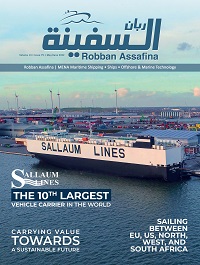World LNG Report 2022
The International Gas Union (IGU) published the 13th edition of the IGU World LNG report, describing the current state of the LNG industry, and the most important trends.
LNG Shipping
There were 641 active LNG vessels as of end-April 2022, including 45 FSRUs and five floating storage units (FSUs). The global fleet grew by 9.9% with the delivery of 57 carriers and four FSRUs in 2021. Most vessels delivered last year are in the 170,000 to 180,000 cubic metres (cm) size range.
The second generation of X-DF and the new generation M-type, electronically gas admission (ME-GA) propulsion systems have gained popularity with 138 X-DF systems across both generations and 41 ME-GA systems on the order book, making up a large share of a total of 217 vessels on order.
Demand recovery from the COVID-19 pandemic, alongside stronger Asian demand catalysed by a colder winter at the start of the year, Chinese coal shortage and stronger industrial demand towards year-end drove a 11.8% growth in the number of LNG voyages.
This is in contrast to 2020 which saw limited growth from the previous year. Charter rates were volatile through 2021, starting at a peak of US$190,000/day for steam turbine vessels, US$255,000/day for TFDE/DFDE vessels and US$290,000/day for X-DF/ME-GI vessels.
This reversed rapidly as winter demand eased, before climbing as the Ever Given container ship blocked the Suez Canal and Europe and Asia competed for cargoes.
With gas pricing hitting record levels by October 2021, rates spiked again, reaching US$140,000/day for steam turbine vessels, US$210,000/day for TFDE/DFDE vessels and US$250,000/day for X-DF/ME-GI vessels in December 2021.
LNG Bunkering Vessels and Terminals
As the global shipping fleet turns to LNG to decarbonise and adhere to stricter environmental regulations, LNG bunkering demand and supply is growing. Bunkering of LNG-fuelled vessels can take place through different methods, including tank-to-ship, truck-to-ship and ship-to-ship transfers.
There are currently 84 LNG bunkering facilities at terminals and ports globally, with 49 in Europe, 24 in Asia, six in North America, four in Australia and one in South America.
Providing ship-to-ship transfers, the LNG bunkering fleet grew by nine vessels in 2021 and two vessels in the first four months of 2022, bringing the global fleet total to 30.
There are an additional 16 vessels on the order book, to be delivered across the globe. The typical size of these vessels is increasing over time – average capacity of the active fleet is 7,200 cm, while the average capacity of vessels on the orderbook is 9,200 cm.
Regasification Terminals
Global regasification capacity has reached 901.9 MTPA as of April 2022, following capacity additions of 49.8 MTPA in 2021, and 4.3 MTPA in the first four months of 2022. Five new regasification terminals started commercial operations, and five expansion projects at existing terminals were successfully completed last year.
New terminals started operations in Indonesia, Croatia, Turkey, Kuwait and Mexico, adding 23.6 MTPA of regasification capacity in 2021, while China and Japan expanded regasification capacity at existing facilities.
In China, some terminals that faced COVID-19- related delays in 2020 became operational in 2021. As of April 2022, 40 markets are equipped with LNG receiving capabilities.
Regasification capacity additions can be anticipated in established markets as well as new import markets. The only new market that joined the ranks of LNG importers in 2021 was Croatia, with operations starting at the Krk LNG terminal.
As of April 2022, 164.8 MTPA of new regasification capacity is under construction, including 19 new onshore terminals, 12 floating storage and regasification units (FSRUs) and 13 expansion projects at existing terminals.
By year-end 2022, 80.4 MTPA of additional capacity is set to come online through newbuild terminals and expansion projects at existing terminals. This includes new importers such as Ghana, Senegal and the Philippines.
Floating and Offshore Regasification
As of April 2022, floating and offshore regasification capacity worldwide stands at 142.6 MTPA with 32 operational terminals. In 2021, FSRUs were commissioned at new terminals in Croatia, Indonesia and Turkey, while FSRUs restarted operations at existing terminals in Brazil and Argentina.
Another 12 floating and offshore regasification terminals are currently under construction, representing a further 44.6 MTPA once commissioned. Ten offshore/floating terminals are scheduled to enter service by end-2022, including new importers such as Ghana and the Philippines.
Established markets have also been expanding their regasification capabilities through chartering FSRUs in 2021. After pandemic and weather-related delays, India is expected to bring its first FSRU-based terminal into service in 2022, equipping the market with both onshore and floating regasification capabilities.
After the onset of the Russia-Ukraine conflict, several European markets have announced plans for new FSRUs to reduce dependence on Russian gas imports. Six countries are planning to operate new FSRUs within the next three years.
LNG Trade
Global LNG trade grew by 4.5% from 2020 to 2021, reaching an alltime high of 372.3 million tonnes (MT), as the strong post-pandemic recovery resulted in a surge in LNG imports.
The growth in exports from 2020 to 2021 was mainly driven by the United States (+22.3 MT, +49.8%), Egypt (+5.2 MT, +390.5%) and Algeria (+1.2 MT, +11.3%). Australia retained its position as the largest LNG exporter in 2021, exporting 78.5 MT last year versus 77.8 MT in 2020.
The largest exporting region continued to be Asia Pacific with total exports of 131.2 MT, in line with 2020 numbers. The Asia Pacific region also continued to be the largest importing region with net imports of 155.7 MT last year, marking an 8.6 MT increase compared to 2020.
China overtook Japan as the largest LNG importer, increasing its net imports from 68.9 MT in 2020 to 79.3 MT in 2021.
As of April 2022, the global LNG trade connects 19 exporting markets with 40 markets with importing capabilities.
Source: Safety4sea
| Read Here | |
 |
|



































